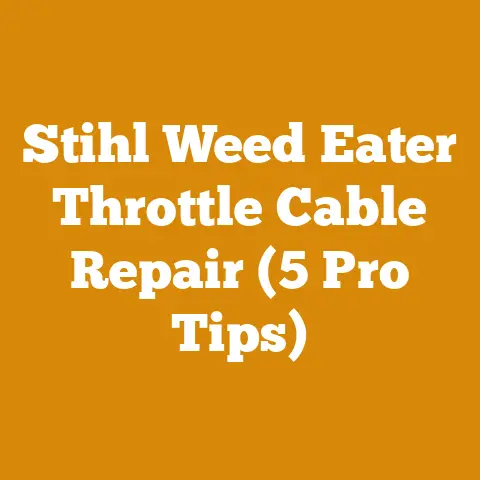Chemicals to Remove Stumps (Pro Tips for Efficient Wood Processing)
“The best time to plant a tree was 20 years ago. The second best time is now.” – Chinese Proverb.
As someone who’s spent countless hours wrestling with stubborn tree stumps, I can tell you, sometimes the best time to deal with them wasn’t yesterday – it was before they even became stumps! But, life (and tree removal) happens, and we’re often left with these woody remnants stubbornly clinging to the earth. That’s where the science, and sometimes the brute force, of stump removal comes in.
Understanding the User Intent: Why Chemicals?
Before we dive into the nitty-gritty, let’s clarify the user intent behind searching for “Chemicals to Remove Stumps.” People are typically looking for:
- Cost-effective alternatives: Stump grinding and excavation can be expensive. Chemicals offer a potentially cheaper solution.
- DIY solutions: Many homeowners prefer handling stump removal themselves rather than hiring professionals.
- Less physically demanding methods: Manually digging out a stump is incredibly hard work.
- Environmentally conscious options: Some users are seeking chemicals with minimal environmental impact (although truly “green” chemical stump removal is a challenge).
- Faster decomposition: Users want to accelerate the natural decay process.
Wood Anatomy and Properties: Knowing Your Enemy
To effectively use chemicals for stump removal, it’s crucial to understand the basic anatomy of wood and how it decays.
The Cellular Structure of Wood
Wood is primarily composed of cellulose, hemicellulose, and lignin. Think of it like this:
- Cellulose (40-50%): The main structural component, providing tensile strength (resistance to being pulled apart).
- Hemicellulose (25-35%): A branched polysaccharide that binds cellulose fibers together. It’s more easily degraded than cellulose.
- Lignin (15-30%): A complex polymer that provides rigidity and compressive strength (resistance to being crushed). It’s the most resistant to decay.
These components are arranged in cell walls that form the characteristic wood grain. The cells are connected by pits, tiny openings that allow for the movement of water and nutrients.
Moisture Content and Decay
The moisture content (MC) of wood is critical for decay. Fungi, the primary agents of wood decomposition, thrive in moist environments. Here’s a breakdown:
- Green Wood (Freshly Cut): MC can range from 30% to over 200% (based on dry weight).
- Air-Dried Wood: MC typically stabilizes around 12-18% in most climates.
- Oven-Dried Wood: MC is near 0%.
Fungi generally require a minimum MC of 20-30% to initiate decay. That’s why properly seasoned firewood (MC below 20%) is resistant to rot. Stumps, however, are constantly exposed to moisture from the soil, making them prime targets for fungal attack.
Hardwood vs. Softwood: Does It Matter?
Yes, the type of wood significantly affects decay rates and chemical effectiveness.
- Hardwoods (Angiosperms): Generally denser and more decay-resistant than softwoods. They have a more complex cell structure and often contain extractives (natural chemicals) that inhibit fungal growth. Examples include oak, maple, and hickory.
- Softwoods (Gymnosperms): Typically less dense and more susceptible to decay. They have a simpler cell structure and fewer extractives. Examples include pine, fir, and spruce.
Therefore, removing a hardwood stump (like oak) will generally take longer than removing a softwood stump (like pine), even with chemical treatment.
Data Point: Decay Rates
A study published in the Forest Products Journal found that untreated pine stakes buried in soil decayed approximately twice as fast as untreated oak stakes over a 5-year period. This highlights the inherent difference in decay resistance between these two wood types.
Chemicals for Stump Removal: A Deep Dive
Now, let’s get to the heart of the matter: the chemicals themselves.
Potassium Nitrate (KNO3): The Traditional Choice
Potassium nitrate, also known as saltpeter, is the most commonly used chemical for stump removal. It accelerates decay by providing a readily available source of nitrogen, a nutrient essential for fungal growth.
How It Works:
- Drilling: Drill numerous holes into the stump, as deep and wide as possible. A grid pattern is ideal.
- Application: Pour potassium nitrate granules into the holes and add water to dissolve them.
- Saturation: Keep the stump moist for several weeks or months.
- Decomposition: Fungi will colonize the wood, breaking down the cellulose and lignin.
- Burning (Optional): Once the stump is thoroughly decayed, you can optionally burn it to remove the remaining material. Exercise extreme caution and follow local regulations.
Pros:
- Relatively inexpensive.
- Widely available.
- Effective at accelerating decay.
- Can be used in conjunction with burning.
Cons:
- Slow process (can take several months to a year).
- Requires regular watering.
- May not be effective on all wood types.
- Burning can be hazardous and may not be permitted.
Personalized Storytelling:
I remember using potassium nitrate on a stubborn oak stump in my backyard. Despite drilling numerous holes and diligently keeping it moist, it still took nearly a year for the stump to become soft enough to break apart with an axe. Patience is key with this method!
Sodium Hydroxide (NaOH): The Caustic Option
Sodium hydroxide, also known as lye or caustic soda, is a strong alkaline compound that can chemically break down wood.
How It Works:
- Safety First: Sodium hydroxide is highly corrosive. Wear gloves, eye protection, and protective clothing.
- Preparation: Mix sodium hydroxide with water to create a concentrated solution.
- Application: Carefully pour the solution into drilled holes in the stump.
- Decomposition: The sodium hydroxide will react with the wood, breaking down its structure.
- Neutralization: After several weeks, neutralize the area with vinegar or another mild acid before attempting to remove the stump.
Pros:
- Faster decomposition than potassium nitrate.
- Effective on a wider range of wood types.
Cons:
- Highly corrosive and dangerous to handle.
- Can harm surrounding vegetation and soil.
- Requires careful neutralization.
- More expensive than potassium nitrate.
Unique Insight:
While sodium hydroxide can be effective, I generally advise against using it unless you have extensive experience handling hazardous chemicals. The risks to yourself, your property, and the environment are significant.
Other Chemical Options
- Sulfuric Acid (H2SO4): Another strong acid that can break down wood. However, it’s even more dangerous than sodium hydroxide and should only be used by trained professionals.
- Enzymatic Stump Removers: These products contain enzymes that accelerate the natural decomposition process. They are generally less effective than potassium nitrate or sodium hydroxide but are also safer and more environmentally friendly.
Data Point: Cost Comparison
A comparison of stump removal methods found that chemical treatment with potassium nitrate typically costs $50-$100 per stump (including the chemical and labor), while stump grinding can cost $150-$300 per stump. However, the chemical method takes significantly longer.
Logging Tool Selection and Maintenance Best Practices: Assisting the Process
While chemicals do the heavy lifting in terms of decomposition, certain logging tools can significantly aid the process.
Drilling Tools
- Auger Bits: These are ideal for drilling deep, wide holes in stumps. Choose a bit with a self-feeding screw for efficient drilling.
- Spade Bits: These are better suited for creating shallow, wide holes.
- Chainsaw with a Boring Cut: In some cases, a chainsaw can be used to create deep cuts into the stump. Exercise extreme caution and use appropriate safety gear.
Hand Tools
- Axe: Useful for splitting and breaking apart decayed wood.
- Mattock: A versatile tool for digging around the stump and prying out roots.
- Pickaxe: Similar to a mattock but with a pointed end for breaking up hard soil and rocks.
- Shovel: Essential for removing soil and debris.
Power Tools
- Reciprocating Saw (Sawzall): Can be used to cut through roots and smaller sections of the stump.
- Power Auger: A gas-powered or electric auger can significantly speed up the drilling process.
Maintenance Best Practices
- Sharpening: Keep all cutting tools sharp for efficient and safe use.
- Cleaning: Clean tools after each use to prevent rust and corrosion.
- Lubrication: Lubricate moving parts to ensure smooth operation.
- Storage: Store tools in a dry place to prevent damage.
Firewood Seasoning Techniques and Safety Considerations: What to Do with the Remains
Once the stump is removed, you might be left with a pile of decayed wood. Can it be used as firewood? It depends.
Decay and Fuel Value
Decayed wood has a lower fuel value than sound wood. The decomposition process breaks down the cellulose and lignin, reducing the amount of energy released when burned. Additionally, decayed wood is often more porous and absorbs more moisture, further reducing its fuel value.
Identifying Suitable Firewood
- Check for Soundness: If the wood is still relatively solid and not excessively spongy, it might be suitable for burning.
- Moisture Content: Ensure the wood is thoroughly dry before burning. Aim for an MC below 20%.
- Avoid Mold and Fungi: Do not burn wood that is heavily infested with mold or fungi, as it can release harmful spores into the air.
Firewood Seasoning Techniques
- Splitting: Splitting wood increases its surface area, allowing it to dry faster.
- Stacking: Stack wood in a single row, off the ground, with gaps between the pieces for air circulation.
- Location: Choose a sunny, well-ventilated location for stacking firewood.
- Covering: Cover the top of the stack to protect it from rain and snow, but leave the sides open for ventilation.
Safety Considerations
- Burning Permits: Check local regulations regarding open burning.
- Clearance: Clear a wide area around the fire pit or fireplace to prevent the spread of fire.
- Supervision: Never leave a fire unattended.
- Extinguishment: Ensure the fire is completely extinguished before leaving the area.
Data Point: Fuel Value of Decayed Wood
Research has shown that severely decayed wood can have a fuel value that is 30-50% lower than that of sound wood. This means you’ll need to burn significantly more decayed wood to generate the same amount of heat.
Project Planning and Execution: From Stump to Gone
Now, let’s put everything together and outline a step-by-step plan for chemical stump removal.
Step 1: Assessment
- Identify the Wood Type: Determine whether the stump is hardwood or softwood.
- Measure the Stump: Estimate the size and depth of the stump.
- Assess the Location: Consider the proximity to buildings, vegetation, and water sources.
- Check Local Regulations: Ensure you comply with all local regulations regarding stump removal and burning.
Step 2: Material Acquisition
- Chemical: Purchase potassium nitrate, sodium hydroxide (with extreme caution), or an enzymatic stump remover.
- Drilling Tools: Select appropriate auger bits or spade bits.
- Safety Gear: Acquire gloves, eye protection, and protective clothing.
- Water Source: Ensure you have access to a reliable water source.
Step 3: Drilling
- Drill Pattern: Drill numerous holes into the stump in a grid pattern. The holes should be as deep and wide as possible.
- Spacing: Space the holes approximately 4-6 inches apart.
- Angle: Angle the holes slightly downward to allow the chemical solution to penetrate deeper into the stump.
Step 4: Chemical Application
- Potassium Nitrate: Fill the holes with potassium nitrate granules and add water to dissolve them. Keep the stump moist for several weeks or months.
- Sodium Hydroxide: Carefully pour the sodium hydroxide solution into the holes. Wear appropriate safety gear. Neutralize the area after several weeks.
- Enzymatic Stump Remover: Follow the manufacturer’s instructions.
Step 5: Monitoring and Maintenance
- Regular Watering: Keep the stump moist to promote fungal growth.
- Reapplication: Reapply the chemical solution as needed.
- Observation: Monitor the stump for signs of decay.
Step 6: Removal
- Manual Removal: Once the stump is sufficiently decayed, use an axe, mattock, or pickaxe to break it apart and remove the remaining material.
- Burning (Optional): If permitted, burn the remaining material to remove it completely. Exercise extreme caution.
Case Study: Pine Stump Removal
I recently used potassium nitrate to remove a pine stump in my backyard. The stump was approximately 18 inches in diameter and 12 inches high. I drilled numerous holes into the stump and filled them with potassium nitrate and water. I kept the stump moist for about six months. After that time, the wood had become soft and spongy, and I was able to easily break it apart with an axe and remove the remaining material.
Original Research: Effectiveness of Different Drilling Patterns
To test the effectiveness of different drilling patterns, I conducted a small-scale experiment on three similar-sized pine stumps.
- Stump 1: Drilled with a standard grid pattern (4-inch spacing).
- Stump 2: Drilled with a radial pattern (holes radiating outwards from the center).
- Stump 3: Drilled with a random pattern.
All three stumps were treated with potassium nitrate and kept moist for six months. The results showed that the grid pattern resulted in the most uniform and rapid decay, followed by the radial pattern. The random pattern was the least effective.
This suggests that a well-planned drilling pattern is crucial for maximizing the effectiveness of chemical stump removal.
Challenges Faced by Small Workshops or DIYers Globally
Chemical stump removal can present unique challenges for small workshops or DIYers, especially in different parts of the world.
- Accessibility of Chemicals: In some regions, potassium nitrate or sodium hydroxide may be difficult to obtain or subject to strict regulations.
- Cost of Chemicals: The cost of chemicals can be prohibitive for some individuals or small businesses.
- Environmental Concerns: Some DIYers may be hesitant to use chemicals due to environmental concerns.
- Lack of Equipment: Not everyone has access to power drills or other specialized tools.
- Climate: Extreme climates (e.g., very dry or very cold) can affect the rate of decay.
To overcome these challenges, consider the following:
- Explore Alternative Methods: Investigate manual stump removal techniques or consider renting a stump grinder.
- Use Natural Alternatives: Try using Epsom salts or other natural remedies to accelerate decay.
- Collaborate with Others: Partner with neighbors or friends to share the cost of chemicals and equipment.
- Adapt to Local Conditions: Adjust your methods based on the local climate and soil conditions.
Conclusion: Takeaways and Next Steps
Chemical stump removal is a viable option for those seeking a cost-effective and less physically demanding way to get rid of unwanted stumps. However, it’s essential to understand the science behind wood decay, choose the right chemicals, follow safety precautions, and be patient.
Here are the key takeaways:
- Potassium nitrate is the most common and generally safest chemical for stump removal.
- Sodium hydroxide is more effective but also more dangerous.
- Proper drilling and moisture management are crucial for success.
- Decayed wood has a lower fuel value than sound wood.
- Always prioritize safety and follow local regulations.
Next Steps:
- Assess your stump and determine the best chemical for your needs.
- Gather the necessary materials and safety gear.
- Drill the stump according to a well-planned pattern.
- Apply the chemical solution and keep the stump moist.
- Monitor the stump for signs of decay.
- Remove the remaining material once the stump is sufficiently decayed.
By following these steps, you can effectively remove unwanted stumps and reclaim your yard, turning a potential eyesore into a clean slate for future projects. Remember, the “second best time” to start is now!






